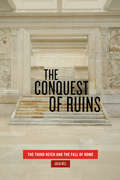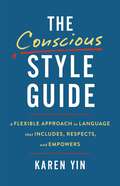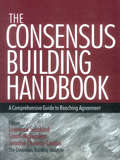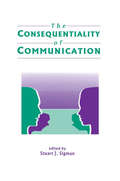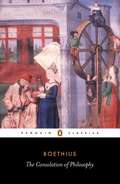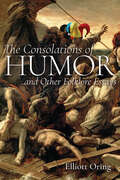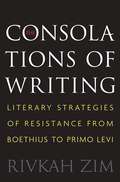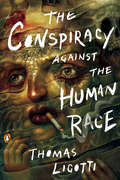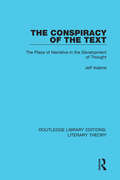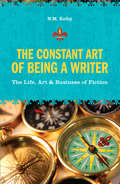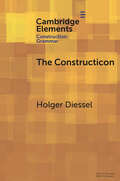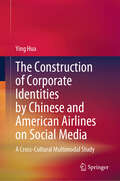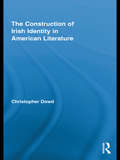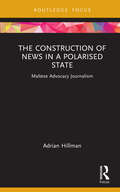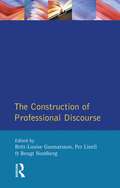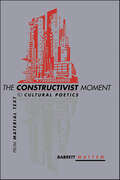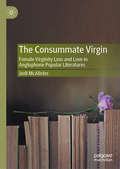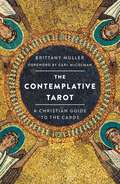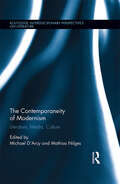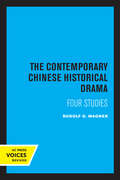- Table View
- List View
The Conquest of Ruins: The Third Reich and the Fall of Rome
by Julia HellThe Roman Empire has been a source of inspiration and a model for imitation for Western empires practically since the moment Rome fell. Yet, as Julia Hell shows in The Conquest of Ruins, what has had the strongest grip on aspiring imperial imaginations isn’t that empire’s glory but its fall—and the haunting monuments left in its wake. Hell examines centuries of European empire-building—from Charles V in the sixteenth century and Napoleon’s campaigns of the late seventeenth and early eighteenth centuries to the atrocities of Mussolini and the Third Reich in the 1930s and ’40s—and sees a similar fascination with recreating the Roman past in the contemporary image. In every case—particularly that of the Nazi regime—the ruins of Rome seem to represent a mystery to be solved: how could an empire so powerful be brought so low? Hell argues that this fascination with the ruins of greatness expresses a need on the part of would-be conquerors to find something to ward off a similar demise for their particular empire.
The Conscious Style Guide: A Flexible Approach to Language That Includes, Respects, and Empowers
by Karen YinA timeless, indispensable guide for anyone who wants to communicate with sensitivity and compassion. Most of us want to choose inclusive, respectful, and empowering language. But language—and how we use it—continually evolves, along with cultural norms. When contradictory opinions muddle our purpose, how do we align our word choices with our beliefs? Who has the final say when people disagree? And why is it so hard to let go of certain words? Afraid of getting something wrong or offending, we too often treat words as dos or don&’ts, regardless of context and nuance. Thankfully, in The Conscious Style Guide, award-winning editor Karen Yin provides a road map for writing and speaking with equity in mind—no matter how the world around us changes. Readers will learn: How to identify biased language How to use inclusive language to bring attention to specific groups of people How to adopt conscious language as a tool for self-awareness and critical thinking How to make digital materials more accessible, from event flyers to websites How to alleviate the stress of experiencing exclusionary language How to collaborate with others and work across differences How to create a style sheet to help support your practice And much more With practical advice and hundreds of relatable examples, The Conscious Style Guide invites us to challenge binary thinking, embrace flexibility and creativity, and explore truly effective communication—in all aspects of our lives.
The Consensus Building Handbook: A Comprehensive Guide to Reaching Agreement
by Sarah McKearnen Jennifer Thomas-Lamar Lawrence E. SusskindWhether you work in the corporate world, a nonprofit organization, or the government sector, you likely face the need to work with others to solve problems and make decisions on a daily basis. And you′ve undoubtedly been frustrated by how laborious and conflict-ridden such group efforts can be. At all levels – from neighborhood block associations to boards of directors of multinational corporations – the consensus building process is highly effective in an increasingly fragmented, contentious society. In addition, the old top-down methods such as Robert′s Rules of Orders often prompt more problems then they solve. Consensus helps you to implement better, more creative solutions. It provides a winning alternative to top-down decision making – and even parliamentary procedure. By learning to build consensus, stakeholders come to understand and respect one another′s perspectives. The consensus building process allows participants to find solutions and forge agreements that meet everyone′s needs – and provides a meaningful basis for effective, long-range implementation of decisions. The Consensus Building Handbook provides a blueprint to help make the process work in your organization, including a practical, quick-reference Short Guide. Plus, you′ll find in-depth commentary and seventeen case studies with in-depth commentaries to provide the theoretical basis for this new approach. CASE STUDIES INCLUDE: Activating a Policy Network: The Case of Mainport Schiphol The Northern Oxford County Coalition: Four Maine Towns Tackle a Public Health Mystery The Chelsea Charter Consensus Process Resolving Science-Intensive Public Policy Disputes: Reflections on the New York Bight Initiative Negotiation Superfund Cleanup at the Massachusetts Military Reservation RuleNet: An Experiment in Online Consensus Building Regulatory Negotiations: The Native American Experience The Chattanooga Process: A City′s Vision Is Realized From City Hall to the Streets: A Community Plan Meets the Real World The Catron County Citizens Group: A Case Study in Community Collaboration Facilitating Statewide HIV/AIDS Policies and Priorities in Colorado Building Consensus for Change Within a Major Corporation: The Case of Levi-Strauss & Company
The Consequentiality of Communication (Routledge Communication Series)
by Stuart J. SigmanIn a bold attempt to redirect the ways theories of communication are conceived and research on communication processes are conducted, this volume questions prevailing communication scholarship that emphasizes the cultural, psychological, and sociological variables that impact on, and/or are impacted by, communication. Instead of focusing on the consequences of communication, this books urges readers to examine the consequentiality of communication -- what it is about the communication process that enables it to play a defining role in our lives. Communication is not a neutral conveyor of meanings derived from culture, cognition, or social structure, and is not explained by correlations with external variables. Meaning emerges from the communication process itself; it is dependent upon what transpires during the real-time moments of communicators behaving with each other. To properly study this new paradigm, a new vocabulary for thinking about the consequentiality of communication is needed and proposed. Four theoretical orientations are used to stake out this new territory: coordinated management of meaning, neo-rhetorical theory, conversation analysis, and social communication theory. While there are points of agreement and overlap on the need to study communication as inherently consequential, there are also differences across the four theories -- in the value of "rules" as an explanatory concept, on the relationship between structure and process, and on the very constitution of a "theory." Thus, this book has the benefit of articulating a new paradigm for communication scholarship without losing sight of the discipline's rich diversity.
The Consolation of Philosophy
by Ancius BoethiusBoethius was an eminent public figure under the Gothic emperor Theodoric, and an exceptional Greek scholar. When he became involved in a conspiracy and was imprisoned in Pavia, it was to the Greek philosophers that he turned. THE CONSOLATION was written in the period leading up to his brutal execution. It is a dialogue of alternating prose and verse between the ailing prisoner and his 'nurse' Philosophy. Her instruction on the nature of fortune and happiness, good and evil, fate and free will, restore his health and bring him to enlightenment. THE CONSOLATION was extremely popular throughout medieval Europe and his ideas were influential on the thought of Chaucer and Dante.
The Consolation of Philosophy
by Anicius Manlius BoethiusIn this highly praised new translation of Boethius’s The Consolation of Philosophy, David R. Slavitt presents a graceful, accessible, and modern version for both longtime admirers of one of the great masterpieces of philosophical literature and those encountering it for the first time. Slavitt preserves the distinction between the alternating verse and prose sections in the Latin original, allowing us to appreciate the Menippian parallels between the discourses of literary and logical inquiry. His prose translations are lively and colloquial, conveying the argumentative, occasionally bantering tone of the original, while his verse translations restore the beauty and power of Boethius’s poetry. The result is a major contribution to the art of translation.Those less familiar with Consolation may remember it was written under a death sentence. Boethius (c. 480–524), an Imperial official under Theodoric, Ostrogoth ruler of Rome, found himself, in a time of political paranoia, denounced, arrested, and then executed two years later without a trial. Composed while its author was imprisoned, cut off from family and friends, it remains one of Western literature’s most eloquent meditations on the transitory nature of earthly belongings, and the superiority of things of the mind. In an artful combination of verse and prose, Slavitt captures the energy and passion of the original. And in an introduction intended for the general reader, Seth Lerer places Boethius’s life and achievement in context.
The Consolations of Humor and Other Folklore Essays
by Elliott OringThe Consolations of Humor and Other Folklore Essays unfolds as a series of questions, commentaries, and criticisms of the analysis, interpretation, and explanation of folklore. Can we confidently regard jokes as the catharsis of sexual and aggressive impulses? What is the basis for characterizing a joke as Jewish or Scottish or Japanese? What do we really know about “dirty jokes”? How is a text or behavior constructed so that it is perceived as humorous? Can we get a computer to reliably recognize jokes? What is the relevance of memetics and a Darwinian paradigm to understanding folklore change over time? Can we identify laws operating in the realm of folklore? How can the marginalization, extinction, or continuity of traditions be explained? In the course of addressing these questions, Elliott Oring identifies some fundamental problems, brings new evidence and observations to the discussion, and proffers some original and startling insights. While recognizing the study of jokes and other forms of folklore as a humanistic endeavor, Oring believes in the relevance of a scientific perspective to the enterprise. He values clear definitions, tests of hypotheses and theories, empirical evidence, experiment, and the search for laws. Written in a sophisticated yet accessible style, The Consolations of Humor and Other Folklore Essays stimulates both scholars and students alike and contributes to the creation of a more robust folkloristics in the twenty-first century.
The Consolations of Writing: Literary Strategies of Resistance from Boethius to Primo Levi
by Rivkah ZimWhy writing in captivity is a vitally important form of literary resistanceBoethius wrote The Consolation of Philosophy as a prisoner condemned to death for treason, circumstances that are reflected in the themes and concerns of its evocative poetry and dialogue between the prisoner and his mentor, Lady Philosophy. This classic philosophical statement of late antiquity has had an enduring influence on Western thought. It is also the earliest example of what Rivkah Zim identifies as a distinctive and vitally important medium of literary resistance: writing in captivity by prisoners of conscience and persecuted minorities.The Consolations of Writing reveals why the great contributors to this tradition of prison writing are among the most crucial figures in Western literature. Zim pairs writers from different periods and cultural settings, carefully examining the rhetorical strategies they used in captivity, often under the threat of death. She looks at Boethius and Dietrich Bonhoeffer as philosophers and theologians writing in defense of their ideas, and Thomas More and Antonio Gramsci as politicians in dialogue with established concepts of church and state. Different ideas of grace and disgrace occupied John Bunyan and Oscar Wilde in prison; Madame Roland and Anne Frank wrote themselves into history in various forms of memoir; and Jean Cassou and Irina Ratushinskaya voiced their resistance to totalitarianism through lyric poetry that saved their lives and inspired others. Finally, Primo Levi's writing after his release from Auschwitz recalls and decodes the obscenity of systematic genocide and its aftermath.A moving and powerful testament, The Consolations of Writing speaks to some of the most profound questions about life, enriching our understanding of what it is to be human.
The Conspiracy against the Human Race: A Contrivance of Horror
by Thomas LigottiIn Thomas Ligotti's first nonfiction outing, an examination of the meaning (or meaninglessness) of life through an insightful, unsparing argument that proves the greatest horrors are not the products of our imagination but instead are found in reality."There is a signature motif discernible in both works of philosophical pessimism and supernatural horror. It may be stated thus: Behind the scenes of life lurks something pernicious that makes a nightmare of our world."His fiction is known to be some of the most terrifying in the genre of supernatural horror, but Thomas Ligotti's first nonfiction book may be even scarier. Drawing on philosophy, literature, neuroscience, and other fields of study, Ligotti takes the penetrating lens of his imagination and turns it on his audience, causing them to grapple with the brutal reality that they are living a meaningless nightmare, and anyone who feels otherwise is simply acting out an optimistic fallacy. At once a guidebook to pessimistic thought and a relentless critique of humanity's employment of self-deception to cope with the pervasive suffering of their existence, The Conspiracy against the Human Race may just convince readers that there is more than a measure of truth in the despairing yet unexpectedly liberating negativity that is widely considered a hallmark of Ligotti's work.
The Conspiracy of the Text: The Place of Narrative in the Development of Thought (Routledge Library Editions: Literary Theory #1)
by Jeff AdamsIn The Conspiracy of the Text, first published in 1986, Jeff Adams looks at an early stage in childhood to examine the ways in which children create social organisation and moral order. Adams shows how certain narratives, such as fairy tales, serve as a foundation for this system, and does this through a fascinating linguistic analysis of a young girl’s reading of her favourite fairy tale, Beauty and the Beast. This title will be of interest to students of literary theory and linguistics.
The Conspiracy of the Text: The Place of Narrative in the Development of Thought (Routledge Library Editions: Literary Theory)
by Jeff AdamsIn The Conspiracy of the Text, first published in 1986, Jeff Adams looks at an early stage in childhood to examine the ways in which children create social organisation and moral order. Adams shows how certain narratives, such as fairy tales, serve as a foundation for this system, and does this through a fascinating linguistic analysis of a young girl’s reading of her favourite fairy tale, Beauty and the Beast. This title will be of interest to students of literary theory and linguistics.
The Constant Art of Being a Writer: The Life, Art and Business of Fiction
by N. M. KelbyThe Fiction Writer's Guide to Creative SuccessFrom that first story idea to publication and beyond, being a novelist is an evolving process. The Constant Art of Being a Writer helps you discover the mindset and skills you need to confidently approach each aspect of writing and publishing.Award-winning novelist and short story writer N.M. Kelby explores core fiction writing techniques like idea generation, outlining, character development, and the use of black comedic moments and magic realism, as well as essential business-related topics like getting an agent, self-promotion, crafting a bestseller, the ins and outs of a successful author tour, and much more.With lively instruction, innovative writing tips, and original exercises, The Constant Art of Being a Writer is a guide you can count on every step of the way.
The Constant Novelist: A Study of Margaret Kennedy, 1896-1967
by Violet PowellA contemporary of such novelists as Rose Macaulay and Elizabeth Bowen, Margaret Kennedy is most widely known as the author of the runaway bestseller The Constant Nymph, published in 1924. However, her work spans more than four decades and is notable for its keen sensitivity to the nuances of human relationships. In this biography, Violet Powell presents Kennedy's life and times and provides critical comments on each of her sixteen novels.
The Constructicon: Taxonomies and Networks (Elements in Construction Grammar)
by Holger DiesselIt is one of the central claims of construction grammar that constructions are organized in some kind of network, commonly referred to as the constructicon. In the classical model of construction grammar, developed by Berkeley linguists in the 1990s, the constructicon is an inheritance network of taxonomically related grammatical patterns. However, recent research in usage-based linguistics has expanded the classical inheritance model into a multidimensional network approach in which constructions are interrelated by multiple types of associations. The multidimensional network approach challenges longstanding assumptions of linguistic research and calls for a reorganization of the constructivist approach. This Element describes how the conception of the constructicon has changed in recent years and elaborates on some central claims of the multidimensional network approach.
The Construction Alphabet Book (Jerry Pallotta's Alphabet Books)
by Jerry PallottaFor fans of all things that go this noisy alphabet book explores construction equipment from A to Z. Find out about these construction machines and more, from a huge saw that cuts through roads to a massive vacuum that sucks up boulders. You'll even learn a quick and easy recipe for concrete. Rock crushers, jackhammers, and wrecking balls will delight the youngest of readers learning their ABCs. Jerry Pallotta's trademark humor punctuates the informative text. Vibrant oil paintings bring to life a busy construction site.
The Construction of Corporate Identities by Chinese and American Airlines on Social Media: A Cross-Cultural Multimodal Study
by Ying HuaUsing top Chinese and American airlines as examples, this book approaches the construction of corporate identities on social media, a critical issue in corporate communication, from a cross-cultural multimodal perspective. Through a holistic and systematic multimodal analysis, it provides a comprehensive cross-cultural understanding of corporate identity construction on social media. By developing an integrated social semiotic framework based on registerial cartography in SFL, it investigates the airlines’ registerial activity patterns in terms of macro-level configuration and micro-level multimodal realizations, interprets their situated contextual patterns that delineate the construction of corporate identities and further explains the influence of cultural factors. Given that this book offers theoretical contributions to corporate identity and cross-cultural communication research, practical guidance on PR practices, especially in the context of Chinese enterprises going global, and pedagogical insights for business communication courses, this book will be of particular benefit to researchers in linguistics, management and communication studies, PR practitioners, and both lecturers and learners of business communication courses.
The Construction of Irish Identity in American Literature (Routledge Transnational Perspectives On American Literature Ser. #13)
by Christopher DowdThis book examines the development of literary constructions of Irish-American identity from the mid-nineteenth century arrival of the Famine generation through the Great Depression. It goes beyond an analysis of negative Irish stereotypes and shows how Irish characters became the site of intense cultural debate regarding American identity, with some writers imagining Irishness to be the antithesis of Americanness, but others suggesting Irishness to be a path to Americanization. This study emphasizes the importance of considering how a sense of Irishness was imagined by both Irish-American writers conscious of the process of self-definition as well as non-Irish writers responsive to shifting cultural concerns regarding ethnic others. It analyzes specific iconic Irish-American characters including Mark Twain’s Huck Finn and Margaret Mitchell’s Scarlet O’Hara, as well as lesser-known Irish monsters who lurked in the American imagination such as T.S. Eliot’s Sweeney and Frank Norris’ McTeague. As Dowd argues, in contemporary American society, Irishness has been largely absorbed into a homogenous white culture, and as a result, it has become a largely invisible ethnicity to many modern literary critics. Too often, they simply do not see Irishness or do not think it relevant, and as a result, many Irish-American characters have been de-ethnicized in the critical literature of the past century. This volume reestablishes the importance of Irish ethnicity to many characters that have come to be misread as generically white and shows how Irishness is integral to their stories.
The Construction of News in a Polarised State: Maltese Advocacy Journalism (Routledge Focus on Communication and Society)
by Adrian HillmanTaking a qualitative approach based on original case studies, this book offers a detailed overview of the contemporary media system in Malta. Three Maltese news organisations are examined to understand the editorial routines, ownership and management structures, and social and cultural factors that affect the day-to-day business of creating news. In-depth interviews with key stakeholders of each organisation are conducted alongside qualitative textual analysis of the content they publish. Contrary to previous research, the work finds that advocacy continues to dominate Maltese journalism, indicating that the country has retained similarities to other media systems within its geographic region. While recognising that the gold standard in journalism is judged to be objectivity and balance, a case is made for a responsible, measured form of advocacy journalism to extend media diversity and contribute to a high level of national political engagement. Presenting an informed case for the need to pay closer attention to small states, especially at a time when many countries are seen to be becoming increasingly socially and politically divided, The Construction of News in a Polarised State is an insightful text for scholars and academics in the fields of media and communication studies, political science, and sociology.
The Construction of Professional Discourse (Language In Social Life)
by Per Linell Bengt Nordberg B.L. GunnarssonInternationally, there is increasing research and interest in the processes of the production and reception of texts for specific purposes and in the historical development of genres and registers within Languages for Specific Purposes (LSP), psycholinguistics, sociolinguistics, anthropology and the sociology of science. Studies of professional communication have traditionally been biased towards the written medium and have been carried out with little, if any, connection to LSP. Disciplinary boundaries and interest groupings have thus kept these different approaches to the study of professional communication and interaction separate. The editors of this volume unite these different perspectives and approaches and bring together recent research from linguistics, sociolinguistics, ethnography of communication, anthropology and sociology to provide an up-to-date analysis of different varieties of professional discourse and their historical development. Chapters written by leading exponents in the field deal with the core theoretical issue of how language, written genres and spoken discourse are constructed as a successive and continuous interplay between language and social realities. The volume includes chapters on the moral construction of discourse in the social care profession, the discourse of dispute negotiation, narrative accounts in clinical research, doctor-patient interaction, legal and other kinds of institutional discourse.A key text for students of applied linguistics and sociolinguistics at both advanced, undergraduate and MA levels.
The Constructivist Moment: From Material Text to Cultural Poetics
by Barrett WattenWinner of the American Comparative Literature Association's Rene Wellek Prize (2004) As one of the founding poets and editors of the Language School of poetry and one of its central theorists, Barrett Watten has consistently challenged the boundaries of literature and art. In The Constructivist Moment, he offers a series of theoretically informed and textually sensitive readings that advance a revisionist account of the avant-garde through the methodologies of cultural studies. His major topics include American modernist and postmodern poetics, Soviet constructivist and post-Soviet literature and art, Fordism and Detroit techno—each proposed as exemplary of the social construction of aesthetic and cultural forms. His book is a full-scale attempt to place the linguistic turn of critical theory and the self-reflexive foregrounding of language by the avant-garde since the Russian Formalists in relation to the cultural politics of postcolonial studies, feminism, and race theory. As such, it will provide a crucial revisionist perspective within modernist and avant-garde studies.
The Consummate Virgin: Female Virginity Loss and Love in Anglophone Popular Literatures
by Jodi McAlisterThis book is a study of female virginity loss and its representations in popular Anglophone literatures. It explores dominant cultural narratives around what makes a “good” female virginity loss experience by examining two key forms of popular literature: autobiographical virginity loss stories and popular romance fiction. In particular, this book focuses on how female sexual desire and romantic love have become entangled in the contemporary cultural imagination, leading to the emergence of a dominant paradigm which dictates that for women, sexual desire and love are and should be intrinsically linked together: something which has greatly affected cultural scripts for virginity loss. This book examines the ways in which this paradigm has been negotiated, upheld, subverted, and resisted in depictions of virginity loss in popular literatures, unpacking the romanticisation of the idea of “the right one” and “the right time”.
The Contemplative Tarot: A Christian Guide to the Cards
by Brittany Muller“This insightful book will help you to see both the cards—and Christian spirituality—in surprising new ways."— Carl McColman, author of The Big Book of Christian Mysticism and Eternal HeartIn the chaos of daily life, many Christians long for the time and mental clarity to reflect on scripture, to worship, and to pray. The Tarot can become an unexpected tool in this journey, inviting us to pause, contemplate, and find insight and wisdom in our walk. In The Contemplative Tarot, author Brittany Muller draws deeply on Christian tradition and theology to create a tarot practice built on spiritual reflection, prayer, and worship.The Tarot has held countless meanings to countless readers over the course of its existence, but The Contemplative Tarot offers a uniquely Christian interpretation of the cards, including Bible verses and meditations on each of their spiritual meanings. Brittany provides practical guidance on how to use the cards in a Christian context, whether as prompts for personal prayer, daily reminders of spiritual truths, or as part of a more structured practice such as the Ignatian examen.The Contemplative Tarot offers a thoughtful, introspective new interpretation of the Tarot and an invitation to create powerful moments of reflection and worship in your daily life.
The Contemporaneity of Modernism: Literature, Media, Culture (Routledge Interdisciplinary Perspectives on Literature)
by Mathias Nilges Michael D'ArcyAt a juncture in which art and culture are saturated with the forces of commodification, this book argues that problems, forms, and positions that defined modernism are crucially relevant to the condition of contemporary art and culture. The volume is attuned to the central concerns of recent scholarship on modernism and contemporary culture: the problems of aesthetic autonomy and the specific role of art in preserving a critical standpoint for cultural production; the relationship between politics and the category of the aesthetic; the problems of temporality and contemporaneity; literary transnationalism; and the questions of medium and medium specificity. Ranging across art forms, mediums, disciplines, and geographical locations, essays address the foundational questions that fuse modernism and the contemporary moment: What is art? What is the relation between art and the economy? How do art and technology interpenetrate and transform each other? What is modernism’s logic of time and contemporaneity, and how might it speak to the problem of thinking genuine novelty, or the possibility of an alternative to the current stage of neo-liberal capitalism? What is modernism, and what is its history? The book is thus committed to revising our understanding of what modernism was in its earlier instantiations, and in accounting for the current moment, addressing the problems raised by modernism's afterlives and reverberations in the 20th and 21st centuries. The volume includes essays that consider literature, sociology, philosophy, visual art, music, architecture, digital culture, television, and other artistic media. It synthesizes the most recent thinking on modernism and contemporary culture and presents a compelling case for what happens to literature, art, and culture in the wake of the exhaustion of postmodernism. This book will be of interest to those studying literature, visual art, media studies, architecture, literary theory, modernism, and twentieth-century and contemporary culture more generally.
The Contemporary Anglophone Travel Novel: The Aesthetics of Self-Fashioning in the Era of Globalization (Literary Criticism and Cultural Theory)
by Stephen M. LevinThe Contemporary Anglophone Travel Novel explores the themes of alienation and displacement in a genre of post-World War II novels that portrays the pursuit of an authentic travel experience in a culturally unfamiliar place. Levin explores two questions: why does travel to an "undiscovered" place—one imagined outside the bounds of modernity—remain an enduring preoccupation in western civilization; and how does the representation of adventure travel change in the era of mass culture, when global capitalism expands at a rapid pace. The book argues that whereas travel writers between the wars romanticized their journeys overseas, travel writing after World War II takes an increasingly melancholic and nihilistic view of a commercial society in which adventure travel no longer proves capable of producing a sense of authentic selfhood. Through close analysis of specific texts and authors, the book provides a rich discussion of anglophone literature in the cultural context of the twentieth-century. It examines the capacity of popular culture for social critique, the relationship between leisure travel and postcolonial cultures, and the idealization of selfhood and authenticity in modern and postmodern culture. The study reflects the best potential of interdisciplinary scholarship, and will prove influential for anyone working in the fields of contemporary literature, cultural theory, and cross-cultural studies.
The Contemporary Chinese Historical Drama: Four Studies
by Rudolf G. WagnerChina's "Great Leap Forward" of 1958-1961 was a time of official rejoicing over the achievements of Communism, but it was also a time of immense suffering. Growing dissent among intellectuals stimulated creativity as writers sought to express both their hope for the success of the revolution and their dissatisfaction with the Party leadership and policies. But the uneasy political climate and the state's control over literature prevented writers from directly addressing the compelling problems of the time. Rather, they resorted to a variety of sophisticated and time-honored forms for airing their grievances, including the historical drama. Rudolf Wagner examines three of these plays written and performed between 1958 and 1963 in an effort to decode their hidden political and cultural meanings. He also provides a broad survey of the politics of the historical drama in China, suggesting further avenues of inquiry into the relationship between literature and the state. This title is part of UC Press's Voices Revived program, which commemorates University of California Press’s mission to seek out and cultivate the brightest minds and give them voice, reach, and impact. Drawing on a backlist dating to 1893, Voices Revived makes high-quality, peer-reviewed scholarship accessible once again using print-on-demand technology. This title was originally published in 1990.
